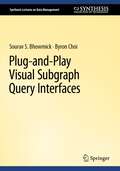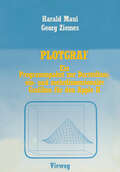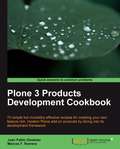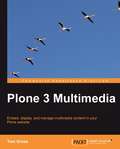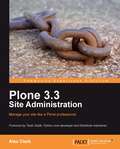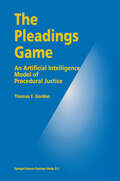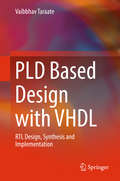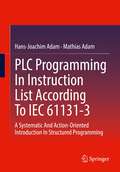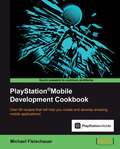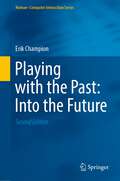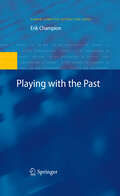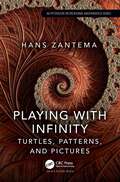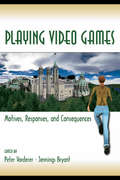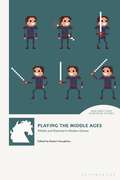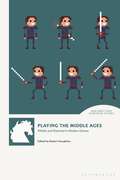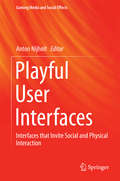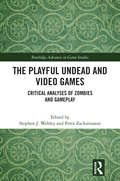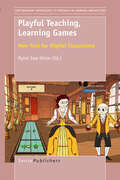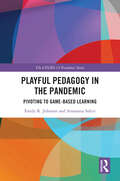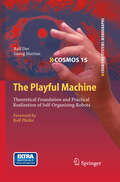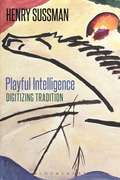- Table View
- List View
Plug-and-Play Visual Subgraph Query Interfaces (Synthesis Lectures on Data Management)
by Sourav S. Bhowmick Byron ChoiThis book details recent developments in the emerging area of plug-and-play (PnP) visual subgraph query interfaces (VQI). These PnP interfaces are grounded in the principles of human-computer interaction (HCI) and cognitive psychology to address long-standing limitations to bottom-up search capabilities in graph databases using traditional graph query languages, which often require domain experts and specialist programmers. This book explains how PnP interfaces go against the traditional mantra of VQI construction by taking a data-driven approach and giving end users the freedom to easily and quickly construct and maintain a VQI for any data sources without resorting to coding. The book walks readers through the intuitive PnP interface that uses templates where the underlying graph repository represents the socket and user-specified requirements represent the plug. Hence, a PnP interface enables an end user to change the socket (i.e., graph repository) or the plug (i.e., requirements) as necessary to automatically and effortlessly generate VQIs. The book argues that such a data-driven paradigm creates several benefits, including superior support for visual subgraph query construction, significant reduction in the manual cost of constructing and maintaining a VQI for any graph data source, and portability of the interface across diverse sources and querying applications. This book provides a comprehensive introduction to the notion of PnP interfaces, compares it to its classical manual counterpart, and reviews techniques for automatic construction and maintenance of these new interfaces. In synthesizing current research on plug-and-play visual subgraph query interface management, this book gives readers a snapshot of the state of the art in this topic as well as future research directions.
PLOTGRAF: Ein Programmpaket zur Darstellung ein- und mehrdimensionaler Grafiken für den Apple II
by Harald MaulPlone 3 Products Development Cookbook: 70 Simple But Incredibly Effective Recipes For Creating Your Own Feature Rich, Modern Plone Add-on Products By Diving Into Its Development Framework
by Marcos F. Romero Juan Pablo GimenezThe examples in this book follow a sample project creating a digital newspaper website to meet the requirements of a fictional customer who wants to place commercial advertisements all over the site. The whole book is a comprehensive collection of recipes that elaborate a series of well known use cases. You will find an organized step-by-step procedure to accomplish each task followed by detailed explanations to better understand how and why each topic was undertaken, and many links to online references and other related sections in the book that can supplement the subject in question. You can read the whole book or just pick the recipes that are relevant for you; where necessary, cross references will help you understand the recipes even if you do not read them in sequential order. his book is for programmers who have some knowledge of Python, Plone, and Zope. If you want to develop feature-rich add-on products in Plone, this book is for you. It is aimed at the development of backend features, so you need not have other web-related skills such as HTML, CSS, or JavaScript.
Plone 3 Multimedia: Embed, Display, And Manage Multimedia Content In Your Plone Website
by Tom GrossThis book is written in a tutorial style where you work through examples that describe how you can create multimedia applications using Plone and integrate your existing multimedia resources into your website. It also tells you how to use multimedia effectively giving many ideas and best practices. This book is for Plone integrators who want to extend the core of Plone with multimedia features. It gives no introduction to Plone and readers should know how to set up a Plone site using a buildout. The book can be read and understood well without being a Python developer, though some examples have Python code included.
Plone 3.3 Site Administration: Manage And Administer Your Plone Site Like A Professional
by Alex ClarkThis book is a step-by-step tutorial guide, explaining many common and fundamentally important Plone site administration tasks. This book is designed for site administrators, webmasters, or content editors managing a site with Plone. These users will not be new to Plone itself, but they will be new to the site administration tasks. The reader is also expected to know basic Python programming. This book caters to these users, and builds their confidence by helping them to get their Plone sites up, running, and customized with minimal peripheral knowledge.
The Pleadings Game: An Artificial Intelligence Model of Procedural Justice
by Thomas F. GordonThe British philosopher Stephan Toulmin, in his The Uses of Argument, made the provocative claim that "logic is generalized jurisprudence". For Toulmin, logic is the study of nonns for practical argumentation and decision making. In his view, mathematical logicians were preoccupied with fonnalizing the concepts of logical necessity, consequence and contradiction, at the expense of other equally important issues, such as how to allocate the burden of proof and make rational decisions given limited resources. He also considered it a mistake to look primarily to psychology, linguistics or the cognitive sciences for answers to these fundamentally nonnative questions. Toulmin's concerns about logic, writing in the 1950's, are equally applicable to the field of Artificial Intelligence today. The mainstream of Artificial Intelligence has focused on the analytical and empirical aspects of intelligence, without giving adequate attention to the nonnative, regulative functions of knowledge representation, problem solving and decision-making. Nonnative issues should now be of even greater interest, with the shift in perspective of AI from individual to collective intelligence, in areas such as multi-agent systems, cooperative design, distributed artificial intelligence, and computer-supported cooperative work. Networked "virtual societies" of humans and software agents would also require "virtual legal systems" to fairly balance interests, resolve conflicts, and promote security.
PLD Based Design with VHDL: RTL Design, Synthesis and Implementation
by Vaibbhav TaraateThis book covers basic fundamentals of logic design and advanced RTL design concepts using VHDL. The book is organized to describe both simple and complex RTL design scenarios using VHDL. It gives practical information on the issues in ASIC prototyping using FPGAs, design challenges and how to overcome practical issues and concerns. It describes how to write an efficient RTL code using VHDL and how to improve the design performance. The design guidelines by using VHDL are also explained with the practical examples in this book. The book also covers the ALTERA and XILINX FPGA architecture and the design flow for the PLDs. The contents of this book will be useful to students, researchers, and professionals working in hardware design and optimization. The book can also be used as a text for graduate and professional development courses.
PLC Programming In Instruction List According To IEC 61131-3: A Systematic And Action-Oriented Introduction In Structured Programming
by Hans-Joachim Adam Mathias AdamThis textbook and exercise book provides a solid basic knowledge and comprehensive practical skills in dealing with PLC programming. Numerous exercises help to deepen the material. With the accompanying simulation software and sample solutions, the acquired knowledge can be applied immediately. The software can be downloaded via the Internet. The knowledge of number systems and digital technology conveyed in the book is an important prerequisite for skilful and clever PLC programming. The programming language used, "Instruction list according to IEC 61131-3", provides the best insights into the functioning of a PLC. The didactically prepared programming examples for switching networks, signal memories, time functions, counters, function blocks and functions, program structures, sequence controls, data types and much more enable systematic learning of programming. The 5th, corrected edition experiences an expansion of the exercises with a didactically prepared project for the control of a mountain railway. The associated simulation software "PLC-lite" enables the realisation of controls for the mountain railway and the "realistic" representation of the cableway movements on the screen.
PlayStation®Mobile Development Cookbook
by Michael FleischauerIn DetailWith the PlayStation®Mobile SDK you can create stunning games for the PlayStation®Vita and PlayStationTCertified devices (PS Certified devices). It includes everything you need to get started, including an IDE for developing your code and even an emulator to test your creations."PlayStation®Mobile Development Cookbook"| is an exciting and practical collection of recipes that help you make the most of this exciting new platform. It provides you with everything you need to create complete 2D or 3D games and applications that fully unlock the potential of the SDK.After quickly covering the basics, you'll learn how to utilize input sources like touch, gamepads, and motion controls, and then move on to more advanced content like creating and animating 2D graphics, networking, playing sound effects and music, adding physics, and then finally jumping into the world of 3D.ApproachWritten as a series of engaging and practical recipes, this essential Cookbook has been meticulously designed and reviewed in order to provide you with the ultimate reference for PlayStation®Mobile development.Who this book is forIf you've got some prior experience with C# and want to create awesome projects for the PlayStation®Vita and PlayStationTCertified devices, then this book is for you.
Playing with the Past: Into the Future (Human–Computer Interaction Series)
by Erik ChampionSince the turn of this century (and even earlier), a plethora of projects have arisen to promise us bold new interactive adventures and immersive travel into the past with digital environments (using mixed, virtual or augmented reality, as well as computer games). In Playing with the Past: Into the Future Erik Champion surveys past attempts to communicate history and heritage through virtual environments and suggests new technology and creative ideas for more engaging and educational games and virtual learning environments.This second edition builds on and updates the first edition with new game discussions, surveys, design frameworks, and theories on how cultural heritage could be experienced in digital worlds, via museums, mobile phones, or the Metaverse. Recent games and learning environments are reviewed, with provocative discussion of new and emerging promises and challenges.
Playing with the Past (Human–Computer Interaction Series)
by Erik ChampionHow can we increase awareness and understanding of other cultures using interactive digital visualizations of past civilizations? In order to answer the above question, this book first examines the needs and requirements of virtual travelers and virtual tourists. Is there a market for virtual travel? Erik Champion examines the overall success of current virtual environments, especially the phenomenon of computer gaming. Why are computer games and simulations so much more successful than other types of virtual environments? Arguments that virtual environments are impeded by technological constraints or by a paucity of evaluation studies can only be partially correct, for computer games and simulations are also virtual environments. Many of the underlying issues are caused by a lack of engagement with the philosophical underpinnings of culture, presence and inhabitation, and there are few exemplars that engage the public with history and heritage using interactive media in a meaningful and relevant manner. The intention of Playing With the Past is to help designers and critics understand the issues involved in creating virtual environments that promote and disseminate historical learning and cultural heritage through a close study of the interactive design principles at work behind both real and virtual places. Topics discussed include the design of virtual environments, and especially virtual heritage environments, virtual place-making, cultural presence, the pros and cons of game-style interaction, augmented reality projects, and appropriate evaluation methods. Virtual heritage environments discussed in the book include projects from Antarctica, Australia, Mexico, Malta, Egypt, Babylon, the Netherlands, Cambodia, and India.
Playing with Infinity: Turtles, Patterns, and Pictures (AK Peters/CRC Recreational Mathematics Series)
by Hans ZantemaThis is a book about infinity - specifically the infinity of numbers and sequences. Amazing properties arise, for instance, some kinds of infinity are argued to be greater than others. Along the way the author will demonstrate how infinity can be made to create beautiful ‘art’, guided by the development of underlying mathematics. This book will provide a fascinating read for anyone interested in number theory, infinity, math art, and/or generative art, and could be used a valuable supplement to any course on these topics.Features: Beautiful examples of generative art Accessible to anyone with a reasonable high school level of mathematics Full of challenges and puzzles to engage readers
Playing with Infinity: Turtles, Patterns, and Pictures (AK Peters/CRC Recreational Mathematics Series)
by Hans ZantemaThis is a book about infinity - specifically the infinity of numbers and sequences. Amazing properties arise, for instance, some kinds of infinity are argued to be greater than others. Along the way the author will demonstrate how infinity can be made to create beautiful ‘art’, guided by the development of underlying mathematics. This book will provide a fascinating read for anyone interested in number theory, infinity, math art, and/or generative art, and could be used a valuable supplement to any course on these topics.Features: Beautiful examples of generative art Accessible to anyone with a reasonable high school level of mathematics Full of challenges and puzzles to engage readers
Playing Video Games: Motives, Responses, and Consequences (Routledge Communication Series)
by Peter Vorderer Jennings BryantFrom security training simulations to war games to role-playing games, to sports games to gambling, playing video games has become a social phenomena, and the increasing number of players that cross gender, culture, and age is on a dramatic upward trajectory. Playing Video Games: Motives, Responses, and Consequences integrates communication, psychology, and technology to examine the psychological and mediated aspects of playing video games. It is the first volume to delve deeply into these aspects of computer game play. It fits squarely into the media psychology arm of entertainment studies, the next big wave in media studies. The book targets one of the most popular and pervasive media in modern times, and it will serve to define the area of study and provide a theoretical spine for future research.This unique and timely volume will appeal to scholars, researchers, and graduate students in media studies and mass communication, psychology, and marketing.
Playing Video Games: Motives, Responses, and Consequences (Routledge Communication Series)
From security training simulations to war games to role-playing games, to sports games to gambling, playing video games has become a social phenomena, and the increasing number of players that cross gender, culture, and age is on a dramatic upward trajectory. Playing Video Games: Motives, Responses, and Consequences integrates communication, psychology, and technology to examine the psychological and mediated aspects of playing video games. It is the first volume to delve deeply into these aspects of computer game play. It fits squarely into the media psychology arm of entertainment studies, the next big wave in media studies. The book targets one of the most popular and pervasive media in modern times, and it will serve to define the area of study and provide a theoretical spine for future research.This unique and timely volume will appeal to scholars, researchers, and graduate students in media studies and mass communication, psychology, and marketing.
Playing the Middle Ages: Pitfalls and Potential in Modern Games (New Directions in Medieval Studies)
by Robert HoughtonThe Middle Ages have provided rich source material for physical and digital games from Dungeons and Dragons to Assassin's Creed. This volume addresses the many ways in which different formats and genre of games represent the period. It considers the restrictions placed on these representations by the mechanical and gameplay requirements of the medium and by audience expectations of these products and the period, highlighting innovative attempts to overcome these limitations through game design and play. Playing the Middle Ages considers a number of important and timely issues within the field including: one, the connection between medieval games and political nationalistic rhetoric; two, trends in the presentation of religion, warfare and other aspects of medieval society and their connection to modern culture; three, the problematic representations of race; and four, the place of gender and sexuality within these games and the broader gaming community. The book draws on the experience of a wide-ranging and international group of academics across disciplines and from games designers. Through this combination of expertise, it provides a unique perspective on the representation of the Middle Ages in modern games and drives key discussions in the fields of history and game design.
Playing the Middle Ages: Pitfalls and Potential in Modern Games (New Directions in Medieval Studies)
The Middle Ages have provided rich source material for physical and digital games from Dungeons and Dragons to Assassin's Creed. This volume addresses the many ways in which different formats and genre of games represent the period. It considers the restrictions placed on these representations by the mechanical and gameplay requirements of the medium and by audience expectations of these products and the period, highlighting innovative attempts to overcome these limitations through game design and play. Playing the Middle Ages considers a number of important and timely issues within the field including: one, the connection between medieval games and political nationalistic rhetoric; two, trends in the presentation of religion, warfare and other aspects of medieval society and their connection to modern culture; three, the problematic representations of race; and four, the place of gender and sexuality within these games and the broader gaming community. The book draws on the experience of a wide-ranging and international group of academics across disciplines and from games designers. Through this combination of expertise, it provides a unique perspective on the representation of the Middle Ages in modern games and drives key discussions in the fields of history and game design.
Playful User Interfaces: Interfaces that Invite Social and Physical Interaction (Gaming Media and Social Effects)
by Anton NijholtThe book is about user interfaces to applications that have been designed for social and physical interaction. The interfaces are ‘playful’, that is, users feel challenged to engage in social and physical interaction because that will be fun. The topics that will be present in this book are interactive playgrounds, urban games using mobiles, sensor-equipped environments for playing, child-computer interaction, tangible game interfaces, interactive tabletop technology and applications, full-body interaction, exertion games, persuasion, engagement, evaluation and user experience. Readers of the book will not only get a survey of state-of-the-art research in these areas, but the chapters in this book will also provide a vision of the future where playful interfaces will be ubiquitous, that is, present and integrated in home, office, recreational, sports and urban environments, emphasizing that in the future in these environments game elements will be integrated and welcomed.
The Playful Undead and Video Games: Critical Analyses of Zombies and Gameplay (Routledge Advances in Game Studies)
by Peter Zackariasson Stephen J. WebleyThis book explores the central role of the zombie in contemporary popular culture as they appear in video games. Moving beyond traditional explanations of their enduring appeal – that they embody an aesthetic that combines horror with a mindless target; that lower age ratings for zombie games widen the market; or that Artificial Intelligence routines for zombies are easier to develop – the book provides a multidisciplinary and comprehensive look at this cultural phenomenon. Drawing on detailed case studies from across the genre, contributors from a variety of backgrounds offer insights into how the study of zombies in the context of video games informs an analysis of their impact on contemporary popular culture. Issues such as gender, politics, intellectual property law, queer theory, narrative storytelling and worldbuilding, videogame techniques and technology, and man’s relation to monsters are closely examined in their relation to zombie video games. Breaking new ground in the study of video games and popular culture, this volume will be of interest to researchers in a broad range of areas including media, popular culture, video games, and media psychology.
The Playful Undead and Video Games: Critical Analyses of Zombies and Gameplay (Routledge Advances in Game Studies)
by Peter Zackariasson Stephen J. WebleyThis book explores the central role of the zombie in contemporary popular culture as they appear in video games. Moving beyond traditional explanations of their enduring appeal – that they embody an aesthetic that combines horror with a mindless target; that lower age ratings for zombie games widen the market; or that Artificial Intelligence routines for zombies are easier to develop – the book provides a multidisciplinary and comprehensive look at this cultural phenomenon. Drawing on detailed case studies from across the genre, contributors from a variety of backgrounds offer insights into how the study of zombies in the context of video games informs an analysis of their impact on contemporary popular culture. Issues such as gender, politics, intellectual property law, queer theory, narrative storytelling and worldbuilding, videogame techniques and technology, and man’s relation to monsters are closely examined in their relation to zombie video games. Breaking new ground in the study of video games and popular culture, this volume will be of interest to researchers in a broad range of areas including media, popular culture, video games, and media psychology.
Playful Teaching, Learning Games:New Tool for Digital Classrooms (Contemporary Approaches to Research in Learning Innovations #5)
by Myint Swe KhineEducators around the world acknowledge the fact that we live in the knowledge society and ability to think systematically is one of the necessary skills in order to function effectively in the 21st century. In the past two decades, popular culture introduced digital games as part of leisure activities for children and adults. Today playing computer games is routine activity for children of all ages. Many have agreed that interactive computer games enhance concentration, promote thinking, increase motivation and encourage socialisation. Educators found their way in introducing game-based learning in science education to entice the students in teaching difficult concepts. Simulation games provide authentic learning experience and virtual world excites the students to learn new phenomena and enliven their inquisitive mind. This book presents recent studies in game-based learning and reports continuing attempts to use games as new tool in the classrooms.
Playful Pedagogy in the Pandemic: Pivoting to Game-Based Learning (The COVID-19 Pandemic Series)
by Emily K. Johnson Anastasia SalterEducational technology adoption is more widespread than ever in the wake of COVID-19, as corporations have commodified student engagement in makeshift packages marketed as gamification. This book seeks to create a space for playful learning in higher education, asserting the need for a pedagogy of care and engagement as well as collaboration with students to help us reimagine education outside of prescriptive educational technology. Virtual learning has turned the course management system into the classroom, and business platforms for streaming video have become awkward substitutions for lecture and discussion. Gaming, once heralded as a potential tool for rethinking our relationship with educational technology, is now inextricably linked in our collective understanding to challenges of misogyny, white supremacy, and the circulation of misinformation. The initial promise of games-based learning seems to linger only as gamification, a form of structuring that creates mechanisms and incentives but limits opportunity for play. As higher education teeters on the brink of unprecedented crisis, this book proclaims the urgent need to find a space for playful learning and to find new inspiration in the platforms and interventions of personal gaming, and in turn restructure the corporatized, surveilling classroom of a gamified world. Through an in-depth analysis of the challenges and opportunities presented by pandemic pedagogy, this book reveals the conditions that led to the widespread failure of adoption of games-based learning and offers a model of hope for a future driven by new tools and platforms for personal, experimental game-making as intellectual inquiry.
Playful Pedagogy in the Pandemic: Pivoting to Game-Based Learning (The COVID-19 Pandemic Series)
by Emily K. Johnson Anastasia SalterEducational technology adoption is more widespread than ever in the wake of COVID-19, as corporations have commodified student engagement in makeshift packages marketed as gamification. This book seeks to create a space for playful learning in higher education, asserting the need for a pedagogy of care and engagement as well as collaboration with students to help us reimagine education outside of prescriptive educational technology. Virtual learning has turned the course management system into the classroom, and business platforms for streaming video have become awkward substitutions for lecture and discussion. Gaming, once heralded as a potential tool for rethinking our relationship with educational technology, is now inextricably linked in our collective understanding to challenges of misogyny, white supremacy, and the circulation of misinformation. The initial promise of games-based learning seems to linger only as gamification, a form of structuring that creates mechanisms and incentives but limits opportunity for play. As higher education teeters on the brink of unprecedented crisis, this book proclaims the urgent need to find a space for playful learning and to find new inspiration in the platforms and interventions of personal gaming, and in turn restructure the corporatized, surveilling classroom of a gamified world. Through an in-depth analysis of the challenges and opportunities presented by pandemic pedagogy, this book reveals the conditions that led to the widespread failure of adoption of games-based learning and offers a model of hope for a future driven by new tools and platforms for personal, experimental game-making as intellectual inquiry.
The Playful Machine: Theoretical Foundation and Practical Realization of Self-Organizing Robots (Cognitive Systems Monographs #15)
by Ralf Der Georg MartiusAutonomous robots may become our closest companions in the near future. While the technology for physically building such machines is already available today, a problem lies in the generation of the behavior for such complex machines. Nature proposes a solution: young children and higher animals learn to master their complex brain-body systems by playing. Can this be an option for robots? How can a machine be playful? The book provides answers by developing a general principle---homeokinesis, the dynamical symbiosis between brain, body, and environment---that is shown to drive robots to self- determined, individual development in a playful and obviously embodiment- related way: a dog-like robot starts playing with a barrier, eventually jumping or climbing over it; a snakebot develops coiling and jumping modes; humanoids develop climbing behaviors when fallen into a pit, or engage in wrestling-like scenarios when encountering an opponent. The book also develops guided self-organization, a new method that helps to make the playful machines fit for fulfilling tasks in the real world.The book provides two levels of presentation. Students and scientific researchers interested in the field of robotics, self-organization and dynamical systems theory may be satisfied by the in-depth mathematical analysis of the principle, the bootstrapping scenarios, and the emerging behaviors. But the book additionally comes with a robotics simulator inviting also the non- scientific reader to simply enjoy the fabulous world of playful machines by performing the numerous experiments.
Playful Intelligence: Digitizing Tradition
by Henry SussmanThis is a guide, in theory and in practice, to how current technological changes have impacted our interaction with texts and with each other. Henry Sussman rereads pivotal moments in literary, philosophical and cultural modernity as anticipating the cybernetic discourse that has increasingly defined theory since the computer revolution. Cognitive science, psychoanalysis and systems theory are paralleled to current trends in literary and philosophical theory.Chapters alternate between theory and readings of literary texts, resulting in a broad but rigorously grounded framework for the relation between literature and computer science. This book is a refreshing perspective on the analog-orientated tradition of theory in the humanities – and offers the first literary-textual genealogy of the digital.
